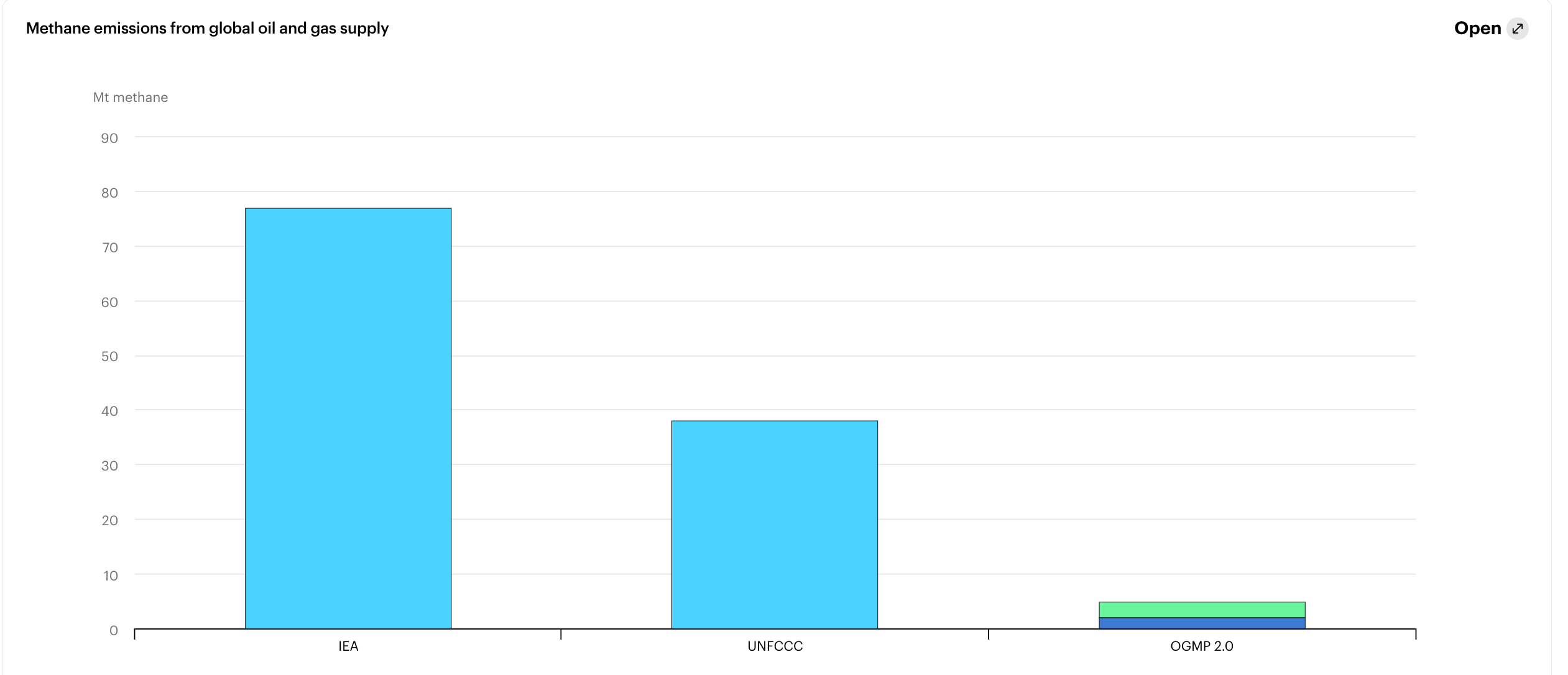Sign up for daily news updates from CleanTechnica on email. Or follow us on Google News!
Remember those golden days when natural gas was a clean-burning bridge fuel, a nice way to reduce emissions as we ditched coal and switched to renewables? It was such a pleasant fantasy, while it lasted. Remember how the USA has a shared dream that it has world-beating emissions reductions because of natural gas displacing coal? Into this pleasant dream some harsh realities intrude.

What’s this chart, you ask? It’s the International Energy Agency’s 2024 methane tracker chart on the countries with the worst methane emissions from their oil and gas industries. Which country is number one with a bullet? That would be the United States. On a related note, did you know that the United States is also the world’s largest producer of oil by volume? As of 2021, the USA was pumping 50% more oil than Saudi Arabia. Something has to go in the the massive gas tanks in the country’s SUVs and oversized pickups.
Yes, the United States has the worst oil and gas methane emissions in the world. No surprise, as it has the most unconventional oil and gas extraction, shale oil and its ugly sibling fracking, both of which lead to high emissions. And no surprise as unlike Norway — note its 0.01% well to end use emissions — it’s paid approaching zero attention to methane leakage until recently.
That roughly 13.5 million tons is equivalent to 1.35 billion tons of carbon dioxide with the 10-year global warming potential of methane, 1.2 billion tons with the 20-year GWP, and 400 million tons with the 100-year GWP. Remember that the world’s total carbon dioxide emissions are only around 40 billion tons a year. The USA’s methane emissions are equivalent to over 3% of that in the short term and 1% at the longest scale we consider.
Those coal cutbacks aren’t looking so hot all of a sudden. If the USA stopped reporting on only its carbon dioxide emissions curves and started reporting on its greenhouse gas emissions curves, it wouldn’t be crowing. And it shouldn’t be crowing.
This is no surprise to anybody who has been paying attention to the US oil and gas industry’s methane emissions of course. Robert Howarth of Cornell has been tracking US emissions for decades and has testified to Congress about it. I assessed his lifecycle accounting study with Mark Z. Jacobson against an European LCA study a couple of years ago. Part of the challenges of the competing LCAs was that the Europeans were looking at Norway, and Howarth and Jacobson were looking at the USA.
In a similar kick-in-the-gut to the methane-is-a-solution crowd, the International Council on Clean Transportation reported in January on its two-year long FUMES study. Nice acronym, which stands for fugitive and unburned methane emissions on ships. As I’ve discovered recently, methane is a big shipping fuel these days and it’s not just for liquid natural gas (LNG) tankers. In fact, it’s become the most popular replacement shipping fuel over the past 20 years, with passenger vessels including cruise ships and ferries opting for it in droves. Even its advocates only claim 30% carbon dioxide emissions reductions, but it does avoid particulates and sulfur, so there’s that.
But the ICCT study was formed to double-check assumptions. They used a variety of sensors to measure actual smokestack emissions of methane over a two-year period. And they found that the most common ship engines, low-pressure dual-fuel (LPDF) four-stroke engines, were slipping 6.4% of the methane fed to them directly into the atmosphere instead of the assumed 3.5%.
Let’s tease that out a bit. A ton of very low sulfur fuel oil (VLSFO) turns into about 3.15 tons of carbon dioxide when burned. A ton of natural gas turns into about 2.75 tons of carbon dioxide when burned. Seems like a good deal, right?
But when 6.5% of a ton of natural gas isn’t burned but escapes to the atmosphere, that’s like 6.5 tons of carbon dioxide over 10 years, 6 tons over 20 years, and 1.9 tons over 100 years. Burning natural gas in the most common maritime engines is actually worse than burning the most common current maritime shipping fuel from a global warming perspective.
I discussed aspects of this recently with Roberta Cenni, Head of Biofuels at the Mærsk McKinney Møller Center for Zero Carbon Shipping. Cenni is a PhD and chemical engineer, and has been focused on biomethane for a shipping fuel in recent years. I’m on record as being concerned about any energy pathway that includes methane more than momentarily due to leakage, and the subject came up. Cenni is in an interesting position as founding firm Maersk, representatives of which she has weekly discussions with, are focused on green methanol instead, for at least overlapping concerns to mine. I’m also on record as considering Maersk’s methanol position to be the best of the also-ran options and at that only if it only buys biomethanol, not synthetic methanol.
Cenni was clearly challenged by the ICCT findings and was still working through the implications.
But that’s not the end of the problems with burning methane. Let’s return to oil and gas industry and flaring. What’s flaring? Well, when there’s too much natural gas because it’s an unwanted by product of shale oil extraction — that is, it’s being produced in unmarketable but still significant amounts — or because antiquated natural gas infrastructure has an overpressure situation and needs to relieve that pressure in much the same way we do, there are four choices in diminishing degrees of badness.
The first choice is just to vent it to the atmosphere. No harm, no foul, except for the massive global warming potential of the substance.
The second choice is to burn it in the open air as a huge gas flame. Open air combustion of natural gas is ineffective because it maximizes the amount of methane that just escapes to the atmosphere and the amount of nitrous oxides produced. One of the nitrous oxides has a much worse global warming potential than methane, and the other produces asthma-inducing smog that hurts kids’ lungs.
So best practice among the non-best practice types is to burn it in a flare stack which maximizes combustion. That’s the third choice. Except that there are a multitude of problems with this in reality. The first is that a lot of flare stacks just aren’t well designed, engineered, or maintained. A bunch of them, it turns out, are malfunctioning. And since no one really cared about methane until recently, no one noticed.
And then there’s the next problem with flare stacks. They are unpopular with the neighbors as big emitters of smoke and visible stuff. So we get into the human cognitive problem. That’s right, in a bunch of places where flare stacks were built to reduce greenhouse gas emissions, local staff just don’t ignite them because they make the neighbors unhappy. So all of that methane just pours into the atmosphere.
This reminds me of Walkerton, Ontario, in 2000. What happened there? Well, a couple of local brothers were the guys tasked with operating the local drinking water purification facility. They didn’t know what E. coli was or why adding chlorine to the drinking water to kill it was important.
E. coli, a bacteria commonly found in the digestive systems of humans and animals, can lead to serious health issues when pathogenic strains are ingested. Symptoms range from mild diarrhea to severe infections, including urinary tract infections, respiratory illness, and pneumonia. Some strains, like E. coli O157:H7, can cause kidney failure and even death, particularly in young children and the elderly. Oops. And a big rain spilled a bunch of cow manure into the drinking water.
This wouldn’t have been a problem if the brothers had been maintaining the levels of chlorine in the drinking water to kill the nasty bacteria. But they had no clue and so were responding to complaints from sensitive locals about the chlorine taste of the water and reducing chlorine levels over time.
Walkerton had 5,000 inhabitants at the time. 2,000 in the area were sickened. Seven died. Because a couple of local brothers with no clue were responding to the complaints of other locals with no clue.
One of my filters for climate solutions is respect human nature. That cuts both ways. Don’t expect a bunch of people to behave better because it’s other people’s survival or even comfort relies on it. And do expect people to mess up on basic things like chlorinating water or not burning methane unless they are inspected regularly.
 Chip in a few dollars a month to help support independent cleantech coverage that helps to accelerate the cleantech revolution!
Chip in a few dollars a month to help support independent cleantech coverage that helps to accelerate the cleantech revolution!
That’s the non-best practices types. What are the best practices types doing? Well, they are designing all infrastructure to capture all methane in overpressure and similar situations and putting it back in the pipes. They aren’t venting, flaring or burning methane at all.
Methane has been having a bad year or two. But is there more? Oh, yes there is. One of the things that I’ve been engaged with for the last 18 months is an EU-Canada dialogue on a measurement-based emissions framework centered around OGMP 2.0. The Oil & Gas Methane Partnership 2.0 is a United Nations Environment Programme initiative aimed at reducing methane emissions from the oil and gas sector. It provides a framework for companies to report methane emissions with a high level of accuracy and transparency. By participating in OGMP 2.0, companies commit to identifying and mitigating methane leaks, contributing to global efforts to combat climate change. The program emphasizes collaboration and sharing best practices among members to achieve significant methane reductions.
OGMP 2.0 has five levels, with the fifth level being a multi-sensor strategy with reconciliation and targets for ongoing emissions reductions. It’s a good and global strategy and a reasonable number of oil and gas firms are signing onto it. How’s it doing so far?

That squat, two-toned bar on the right is what OGMP 2.0 is tracking right now. It’s new, but that’s not a good look compared to the emissions reality. And to be clear, the IEA is trying to get this right with modern measurement systems, especially satellite methane emission systems with MethaneSat and GHGSat up there now. For that matter, there’s even a way to use weather satellite data to detect methane.
This might be problematic for the business model of Orbital Sidekick, a firm with a small fleet of hyperspectral imaging satellites selling its services to oil and gas firms to monitor their emissions. I talked with Dan Katz, founder and CEO of the firm, not long ago and while his corporate story of building their first satellite in his California garage with components baked in a cannabis oven is an amazing Silicon Valley founder tale, it might not be able to compete with Google’s funding of MethaneSat. A rule of thumb I have is that if you accidentally end up competing with Apple, Google, Amazon, or Facebook, you’re unlikely to succeed. I wish Katz and Orbital Sidekick well.
OGMP 2.0 doesn’t have a lot of penetration yet. Only one Canadian-owned firm is a member for example, and you’ll note Canada is in the top ten emitters list. Yes, our oil and gas industry is leaky too. Much of that is due to cold heavy oil processing with sand (CHOPS) but the country is doing a lot of fracking too. And, of course, oil sands are by definition unconventional oil processing with its tendency for greater methane emissions.
OGMP 2.0 is tearing a bandage off of an unhealed wound right now. Every time an oil and gas firm commits to OGMP 2.0 and starts measuring its actual as opposed to modeled emissions, they find that they are both higher and not where they thought they were. During the EU-Canada dialogue workshop I facilitated in Calgary recently, the UN OGMP.20 lead described a US firm that had 2.3 times the emissions that they thought they did and much higher emissions from trying to burn methane for power or as a waste byproduct than they had realized.
Similarly, Shell’s division in Canada found that instead of leaky pipes, it was ineffective burning of natural gas in flaring and engines used to power facilities that were the big hitters. And so, ironically, Shell’s high-priority solution is to electrify its operations. That’s right, it is going to stop burning its own product and use electric motors because that’s a climate solution that actually works.
Have a tip for CleanTechnica? Want to advertise? Want to suggest a guest for our CleanTech Talk podcast? Contact us here.
Latest CleanTechnica TV Video
CleanTechnica uses affiliate links. See our policy here.





